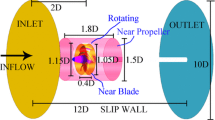Abstract
Various computational approaches differing in complexity and accuracy can be used to simulate flows around rotating lifting surfaces. Here, the flow field around a hovering propeller is estimated by two disparate methods, Reynolds-averaged Navier-Stokes (RANS) equations vs. wall-modelled large eddy simulation (WMLES), and compared to experimental data. In both cases, the computed thrust is somewhat lower than the measured value, mostly because the measuring equipment, located behind the propeller, disrupted the wake, thus changing the aerodynamic loads over the blades. However, the effect of the computational grids and approaches to resolving the rotational motion and turbulence are not negligible. They can be quantified in a particular case of a small-scale propeller operating at nominal angular frequency. For that reason, different computational domains, grids and numerical set-ups are tried and compared. It is observed that by careful geometric modelling, fine meshes, LES and inclusion of actual experimental set-up, a much-improved correspondence between the two sets of data can be achieved.
Access this chapter
Tax calculation will be finalised at checkout
Purchases are for personal use only
Similar content being viewed by others
Abbreviations
- P:
-
Power
- R:
-
Rotor Radius
- T:
-
Thrust
- Q:
-
Torque
References
Delorme, Y., Stanly, R., Frankel, S. H., & Greenblatt, D. (2021). Application of actuator line model for large Eddy simulation of rotor noise control. Aerospace Science and Technology, 108, 106405.
Herniczek, M. K., Jee, D., Sanders, B., & Feszty, R. (2019). Rotor blade optimization and flight testing of a small UAV rotorcraft. Journal of Unmanned Vehicle Systems, 7(4), 325–344.
Kovačević, A., Svorcan, J., Hasan, M. S., Ivanov, T., & Jovanović, M. (2021). Optimal propeller blade design, computation, manufacturing and experimental testing. Aircraft Engineering and Aerospace Technology, 93(8), 1323–1332.
Leishman, J. G. (2006). Principles of helicopter aerodynamics. Cambridge University Press.
Svorcan, J., & Ivey, C. (2022). WMLES of a small-scale hovering propeller. ISUDEF 2022, Madrid, Spain.
Zhao, Q., & Sheng, C. (2022). Predictions of HVAB rotor in hover using hybrid RANS/LES methods-II. AIAA SciTech Forum 2022, AIAA, AIAA 2022–1550.
Acknowledgements
J. S. conducted this research during a Fulbright Fellowship at Stanford University, Center for Turbulence Research in November 2021. This work is also supported by the Ministry of Education, Science and Technological Development of the Republic of Serbia through contract no. 451-03-68/2022-14/200105.
The GPU-accelerated simulations in this paper were performed using “Chapman” at the Center for Turbulence Research.
Author information
Authors and Affiliations
Corresponding author
Editor information
Editors and Affiliations
Rights and permissions
Copyright information
© 2024 The Author(s), under exclusive license to Springer Nature Switzerland AG
About this paper
Cite this paper
Svorcan, J., Wang, K., Kovačević, A. (2024). Accounting for the Effects of Experimental Setting in Propeller Flow Computation. In: Karakoc, T.H., et al. Novel Techniques in Maintenance, Repair, and Overhaul. ISATECH 2022. Sustainable Aviation. Springer, Cham. https://doi.org/10.1007/978-3-031-42041-2_9
Download citation
DOI: https://doi.org/10.1007/978-3-031-42041-2_9
Published:
Publisher Name: Springer, Cham
Print ISBN: 978-3-031-42040-5
Online ISBN: 978-3-031-42041-2
eBook Packages: EnergyEnergy (R0)




